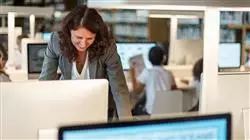University certificate
The world's largest faculty of education”
Introduction to the Program
A process of professional growth that will allow you to include everything you have learned in your work with the security of an expert in the field"

Biology and Geology Teacher Training Program in High School Education is designed to improve the student's competencies as a future teacher through the most innovative educational technology and on a hybrid learning basis.
This degree is distinguished by the fact that its contents can be taken 100% online, adapting to the needs and obligations of the student, in an asynchronous and completely self-manageable manner. The student will be able to choose which days, at what time and for how long to dedicate to the course of the contents of the program. Always in tune with the skills and capabilities dedicated to it.
The order and distribution of the subjects and their units is specially designed to allow each student to choose their own schedule and self-manage their time. For this purpose, you will have at your disposal theoretical materials presented through enriched texts, multimedia presentations, exercises and guided practical activities, motivational videos, master classes and case studies, where you will be able to evoke knowledge in an orderly manner and work on decision making that demonstrates your high level education within this field of teaching.
TECH presents the Professional PROGRAM in Biology and Geology Teacher Training in High School Education with the highest quality in the university market”
This Professional master’s degree in Biology and Geology Teacher Training in High School Education contains the Educational most complete and up-to-date program on the market. Its most notable features are:
- The development of practical cases presented in simulated scenarios by experts in the field of study, where the student will evoke in an orderly manner the knowledge learned and demonstrate the acquisition of the competencies
- The graphic, schematic, and practical contents with which they are created, provide scientific and practical information on the disciplines that are essential for professional practice
- The latest developments on the educational task of the high school teacher
- Practical exercises where to perform the self-assessment process to improve learning, as well as activities at different levels of competence, according to Miller's model
- Special emphasis on innovative methodologies and teaching research
- Theoretical lessons, questions to the expert, debate forums on controversial topics, and individual reflection assignments
- Content that is accessible from any fixed or portable device with an internet connection
This Professional master’s degree may be the best investment you can make when selecting a refresher program, for two reasons: in addition to expanding your knowledge in teaching, you will obtain a qualification endorsed by TECH Global University"
Its teaching staff includes professionals belonging to the field of Teacher Training, who bring to this program their work experience, as well as recognized specialists from prestigious reference societies and universities.
The multimedia content, developed with the latest educational technology, will provide the professional with situated and contextual learning, i.e., a simulated environment that will provide immersive education programmed to learn in real situations.
The design of this program focuses on Problem-Based Learning, by means of which the teacher must try to solve the different situations of professional practice that arise throughout the Professional master’s degree. For this purpose, the teacher will be assisted by an innovative interactive video system developed by renowned experts in the field of Geography and History teaching with extensive teaching experience.
Choose your specialty and take the program that will lead you to professional excellence"

This 100% online Professional master’s degree will allow you to balance your studies with your professional work while increasing your knowledge in this field"
Why study at TECH?
TECH is the world’s largest online university. With an impressive catalog of more than 14,000 university programs available in 11 languages, it is positioned as a leader in employability, with a 99% job placement rate. In addition, it relies on an enormous faculty of more than 6,000 professors of the highest international renown.

Study at the world's largest online university and guarantee your professional success. The future starts at TECH”
The world’s best online university according to FORBES
The prestigious Forbes magazine, specialized in business and finance, has highlighted TECH as “the world's best online university” This is what they have recently stated in an article in their digital edition in which they echo the success story of this institution, “thanks to the academic offer it provides, the selection of its teaching staff, and an innovative learning method aimed at educating the professionals of the future”
A revolutionary study method, a cutting-edge faculty and a practical focus: the key to TECH's success.
The most complete study plans on the university scene
TECH offers the most complete study plans on the university scene, with syllabuses that cover fundamental concepts and, at the same time, the main scientific advances in their specific scientific areas. In addition, these programs are continuously being updated to guarantee students the academic vanguard and the most in-demand professional skills. In this way, the university's qualifications provide its graduates with a significant advantage to propel their careers to success.
TECH offers the most comprehensive and intensive study plans on the current university scene.
A world-class teaching staff
TECH's teaching staff is made up of more than 6,000 professors with the highest international recognition. Professors, researchers and top executives of multinational companies, including Isaiah Covington, performance coach of the Boston Celtics; Magda Romanska, principal investigator at Harvard MetaLAB; Ignacio Wistumba, chairman of the department of translational molecular pathology at MD Anderson Cancer Center; and D.W. Pine, creative director of TIME magazine, among others.
Internationally renowned experts, specialized in different branches of Health, Technology, Communication and Business, form part of the TECH faculty.
A unique learning method
TECH is the first university to use Relearning in all its programs. It is the best online learning methodology, accredited with international teaching quality certifications, provided by prestigious educational agencies. In addition, this disruptive educational model is complemented with the “Case Method”, thereby setting up a unique online teaching strategy. Innovative teaching resources are also implemented, including detailed videos, infographics and interactive summaries.
TECH combines Relearning and the Case Method in all its university programs to guarantee excellent theoretical and practical learning, studying whenever and wherever you want.
The world's largest online university
TECH is the world’s largest online university. We are the largest educational institution, with the best and widest online educational catalog, one hundred percent online and covering the vast majority of areas of knowledge. We offer a large selection of our own degrees and accredited online undergraduate and postgraduate degrees. In total, more than 14,000 university degrees, in eleven different languages, make us the largest educational largest in the world.
TECH has the world's most extensive catalog of academic and official programs, available in more than 11 languages.
Google Premier Partner
The American technology giant has awarded TECH the Google Google Premier Partner badge. This award, which is only available to 3% of the world's companies, highlights the efficient, flexible and tailored experience that this university provides to students. The recognition as a Google Premier Partner not only accredits the maximum rigor, performance and investment in TECH's digital infrastructures, but also places this university as one of the world's leading technology companies.
Google has positioned TECH in the top 3% of the world's most important technology companies by awarding it its Google Premier Partner badge.
The official online university of the NBA
TECH is the official online university of the NBA. Thanks to our agreement with the biggest league in basketball, we offer our students exclusive university programs, as well as a wide variety of educational resources focused on the business of the league and other areas of the sports industry. Each program is made up of a uniquely designed syllabus and features exceptional guest hosts: professionals with a distinguished sports background who will offer their expertise on the most relevant topics.
TECH has been selected by the NBA, the world's top basketball league, as its official online university.
The top-rated university by its students
Students have positioned TECH as the world's top-rated university on the main review websites, with a highest rating of 4.9 out of 5, obtained from more than 1,000 reviews. These results consolidate TECH as the benchmark university institution at an international level, reflecting the excellence and positive impact of its educational model.” reflecting the excellence and positive impact of its educational model.”
TECH is the world’s top-rated university by its students.
Leaders in employability
TECH has managed to become the leading university in employability. 99% of its students obtain jobs in the academic field they have studied, within one year of completing any of the university's programs. A similar number achieve immediate career enhancement. All this thanks to a study methodology that bases its effectiveness on the acquisition of practical skills, which are absolutely necessary for professional development.
99% of TECH graduates find a job within a year of completing their studies.
Professional Master's Degree in Geology and Biology Teacher Training in Secondary Education
If you are passionate about biology and geology and want to take your teaching career to the next level, look no further. TECH Global University presents its Professional Master's Degree in Teacher Training in Biology and Geology in Secondary Education, designed to strengthen your knowledge and skills as a teacher in these fundamental disciplines. With our online classes, you can access quality education from the comfort of your home or any place you choose. We eliminate geographical barriers and rigid schedules, giving you the flexibility to learn at your own pace. In addition, our online classes encourage interaction and active participation through virtual learning platforms, where you can connect with expert teachers and classmates. In the program, you will be immersed in a comprehensive and up-to-date curriculum that covers the key concepts of these two disciplines. Through innovative teaching approaches, you will explore topics such as evolution, planetary geology, ecosystems and environmental sustainability. Our program is designed to provide you with a thorough understanding of biology and geology content and teaching methods, as well as the pedagogical skills necessary to create an effective and stimulating learning environment for your students.
Develop the pedagogical skills necessary to create an effective and stimulating learning environment for your students.
Develop the skills necessary for good teaching of geology and biology
At our institution we have a highly qualified and experienced teaching team in the field of science education. They will guide you throughout your academic journey, providing personalized guidance and support to help you achieve your career goals. Upon completion of the Professional Master's Degree you will be prepared to meet the challenges of secondary school teaching and help your students develop strong science knowledge and critical skills. You will earn a degree recognized by TECH Global University, validating your competencies as a biology and geology educator. Join us and make a difference as a secondary biology and geology teacher!







